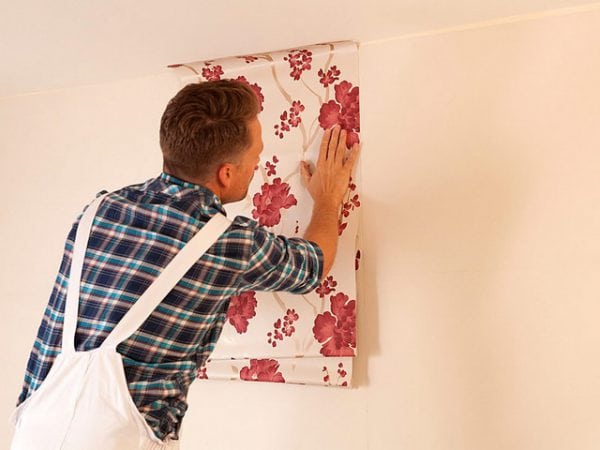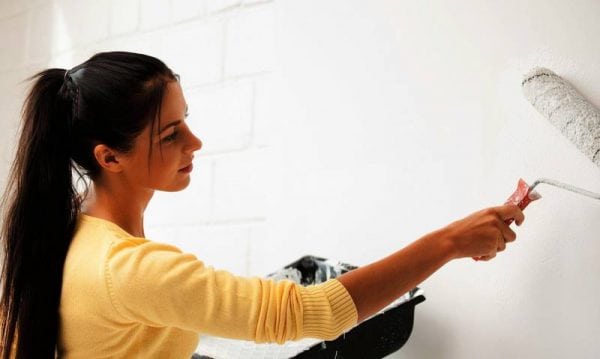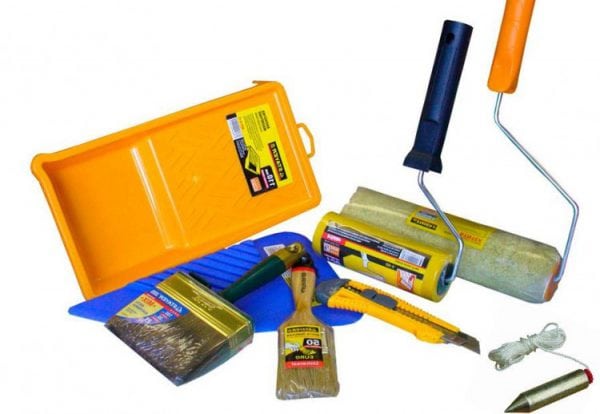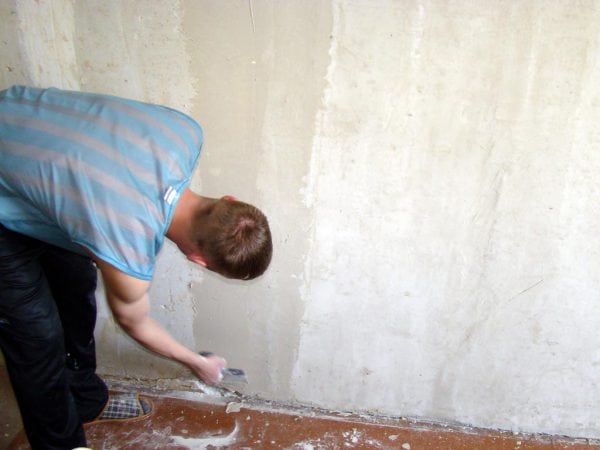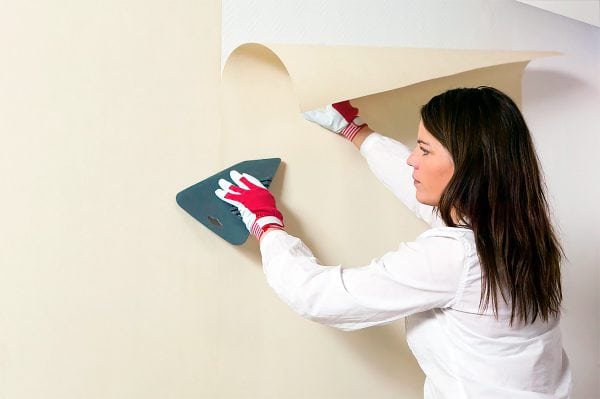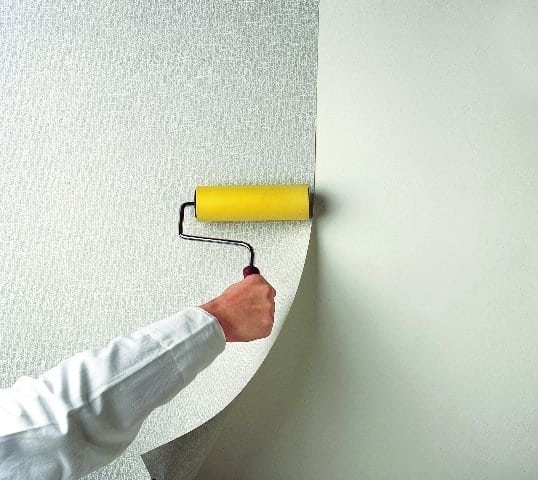Thanks to the simple technology, many home masters prefer to update the interior by wallpapering the walls. But what if the walls were previously painted with an aqueous emulsion? How to glue wallpaper on water-based paint and can it be done at all?
- Determine the type of coating
- Training Issues
- Creating a rough surface
- Primer and putty
- Do I need plaster
- Wallpaper Advice
- Required Inventory
- Wallpaper Sticking Steps
- Coating Quality Assessment
- Wet surface treatment
- Surface alignment
- Primer coating
- Sticking
- Good to know
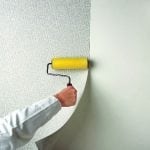
Determine the type of coating
Before proceeding directly to gluing the walls covered with paint, it is important to establish what the basis of this paint. To avoid possible troubles, it is necessary to prepare the surface. To completely eliminate defects in the wallpaper in the future, it is better to completely remove the old coating.
Determining the type of paint is easy. In the rooms, in most cases, two types of paints are used:
- Oil - characterized by high resistance to moisture and a specific smell. Such paint lays down as an integral coating, and with the course of time it easily peels off in pieces.
- Water-based paints are odorless, reliably adhere to the base. Aqueous paint is much more difficult to remove from the wall.
to contents ↑If you decide to completely get rid of the previous coating and not to primer (putty) the wall, then it is important to choose a reliable glue for wallpapering. However, one cannot do without washing and completely drying the walls. This method is suitable for working with any wallpaper, except for vinyl.
Training Issues
You will have to get rid of the oil coating. Is it possible to glue wallpaper on water-based paint? Yes, it is possible, but the walls will need to be treated very carefully.
Creating a rough surface
It is necessary to use scrapers, rough sandpaper to remove excess water emulsion and create a rough base that promotes perfect adhesion. The prepared surface should be thoroughly washed and dried.
to contents ↑Attention! Walls with no more than a three-layer coating of water-based paint can simply be washed off with water. In this case, it is necessary to change the water often in order to carefully process each centimeter.
Primer and putty
Before gluing the wallpaper, it is necessary to apply a primer, the choice of which must be based on its adhesive properties. So you can save on the amount of glue and provide a strong fixation of wallpaper. In addition, a high-quality primer provides added protection against mold. Apply the composition several times. Chips and other defects must be pre-coated with putty.
to contents ↑Do I need plaster
Coating the surface with plaster perfectly levels the surface and serves as an excellent basis for fabric paintings or wallpaper on a natural basis.If you chose textured or liquid wallpaper, then they themselves well hide surface irregularities and do not require special preparation of the walls.
Wallpaper Advice
If heavy wallpaper is to be glued, special paper must first be glued. At the same time, it is very important to avoid overlapping joints, since under the weight of the wallpaper the paper may peel off.
Wallpapering on water-based paint involves preliminary application of a mixture of equal parts of glue and primer to the base.
But on a water-based base, wallpapering is allowed only if the paint is of good quality. You can check it yourself. It is enough to glue an ordinary newspaper and try to tear it off in a day. If the paper holds well, then you can safely paste on the wallpaper, otherwise it is better to wash off the paint.
to contents ↑Important! During the repair process, you cannot try to remove the bubbles by peeling off the canvas and gluing it again. Air bubbles can be expelled with a special dense roller or a plastic spatula with a rubber tip that fits snugly against the wall and squeezes the air. Frequent peeling of wallpaper from the surface will weaken the adhesion of the coating, will not allow it to fix in the right way.
Required Inventory
This type of repair implies the presence of:
- tassels;
- roller (for applying glue, removing bubbles);
- stationery knife;
- scissors;
- a pencil.
Some types of wallpaper must be cut with an allowance for alignment. If the drawing needs to be customized, then the necessary pieces need to be cut off as the work progresses. It should be trimmed on the bottom, it is better to remove excess with a clerical knife. Glue can be applied with a roller or brush.
to contents ↑Wallpaper Sticking Steps
In order for the wallpaper to fit well and hold firmly, you need to correctly perform all the stages of repair.
Coating Quality Assessment
If the likelihood of poor adhesion of the paint to the wall is high, it is necessary to remove this area, since subsequently there is a likelihood of the wallpaper moving away under the weight of the glue with torn pieces of paint. Any chips or swellings should be alerted - it is better to get rid of such areas in advance. Preservation of appearance indicates that you can proceed to surface treatment.
Wet surface treatment
If flushing of water-based paint is inevitable, it is better to do it efficiently, possibly using soap. The final stage of wall washing is the use of clean water without additives. After washing, it is necessary to apply soil, but the walls must dry well before that.
Surface alignment
This stage is necessary if the walls have a rough surface or other pronounced bumps. It will be necessary to level the wall with putty, and apply a special mesh to the treated places, which will adhere the solution and prevent further deformation of the wallpaper. Good adhesion of paper to the surface will provide sandpaper processing.
to contents ↑Primer coating
When choosing a primer, it is necessary to rely on its technical characteristics. The soil should get along well with concrete, preferably a light shade. Lay it in several layers. It should be borne in mind that the resulting color of the walls should not appear through the wallpaper.
Sticking
Before proceeding to gluing, you must familiarize yourself with the instructions for the wallpaper itself. Manufacturers give comprehensive information with detailed recommendations for wallpapering, how long they will dry, how to spread with glue, to adjust or not to adjust the picture. To improve the quality and service life, it is worthwhile to lay a special tape at the joints, which will provide additional adhesion to the seam.
Operating procedure:
- Cut the desired piece of wallpaper, in a clean place, lay it down with a pattern.
- Vigorously apply glue to the entire surface of the inside, staining every millimeter, paying particular attention to the edges. It is important that you do not overdo it with the adhesive. It should be applied from the center to the periphery.
- To keep the outside beautiful, glue must be prevented from getting on it.
- It is important to let the wallpaper soak in glue. To do this, it is enough to fold the plastered area with an accordion and leave it plastered for several minutes.
- You should start from the window, carefully monitoring the correct location of the pattern.
Good to know
A few secrets from the masters will help you cope with difficulties in work:
- You can align the oblique overlay with a clean cloth. While the glue is wet, the paper must be carefully moved in the desired direction.
- If the eye is not good enough, you can use a pencil with a ruler to outline the location of the canvas.
- In the case of work with non-woven wallpaper, glue will have to cover the canvas and walls.
- The resulting bubbles can be driven out with a roller or a spatula with a rubber tip.
- When carrying out repairs in the cold season, it is necessary to turn off the heating, since it dries the air and glue.
- Drafts cause harm. It is best to work indoors.
- To reduce the visibility of the seam, the room is glued in the direction away from the window.
- Sockets and switches are removed before gluing, but the place is marked. In the future, the excess can be removed with a clerical knife and carefully insert them back.
- The ideal temperature for drying the adhesive is +18 ° C.
- If there is an arch in the room, then it is necessary to allow a stock of wallpaper equal to the width of the arch, so that the excess is glued to this section.
For a quality result, it is important to remove all paint on the walls. If the previously applied water-based paint still holds well, which must be verified before the gluing process, you can immediately proceed to updating the walls.

